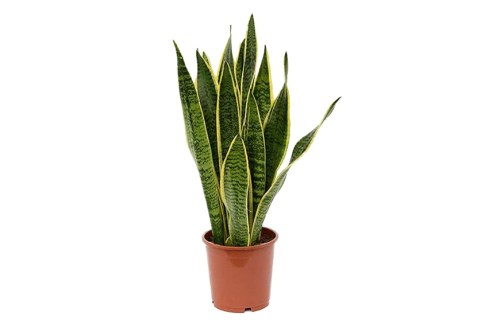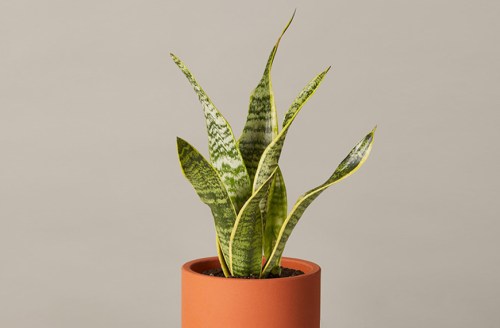My plant obsession has gotten a little out of control over the past couple years. Greenery graces every corner of my apartment—on shelves, in big planters on the floor, on my dresser. I’ve got an urban jungle, and I love it. But even with all the different species I’ve collected, one of my favorites will always be the trusty snake plant.
While some plants are pretty fickle—dying if you even slightly overwater them or don’t give them enough light—sansevieria, better known as the snake plant due to its reptilian leaf pattern and shape, are basically the cockroach of the plant world. And I mean that as the biggest compliment. Although they’re much prettier than the insect to look at, they’re just as tough. Even through the long, dark days of winter, my little guy has never wavered. In fact, somehow he keeps on thriving no matter the conditions, happily sprouting new leaves year-round.
“The snake plant is a great option for beginners for a two big reasons,” says Erin Marino, director of brand marketing at The Sill. “First, it’s technically a drought tolerant succulent. This means you’ll be watering it less frequently than other common houseplants, and when you forget a watering (or two!), it’ll be fine. Second, the snake plant is also low light tolerant. Although snake plants prefer medium to bright light, they can tolerate lower light levels than other common houseplants. This means you can pretty much stick it in any room of your room, as long as there’s a window that receives natural light, be it bright, moderate, or low.”
Even though snake plants are definitely one of the easiest plants to care for—making them especially great for beginners!—there are still some important care tactics to keep in mind if you decide to bring one home.
These 4 snake plant care tips will have your plant thriving
1. Make sure the pot has proper drainage
Snake plants aren’t too picky about their soil: Marino says general indoor potting mix should be fine. But when it comes to the pot situation, having a drainage hole is super important. If they get too soggy from being overwatered or water pools at the bottom of the pot, it could result in root rot.
“If you have a heavy pour with your watering can, I recommend opting for a planter with a drainage hole and saucer,” she says. “If you want to opt for a planter without drainage holes—maybe you have something existing at home—you can line the bottom of the planter with a generous layer of lava rocks to provide a spot for excess water to pool into, away from your plant’s roots.”
2. Find the optimal lighting situation
Sure, snake plants are fine in low light situations. But do they love it? Well, that’s a different story. If you want your snake plant to grow like crazy, your best bet is giving it a little more sunshine.
“Often positioned as a ‘low light plant,’ snake plants actually prefer medium to bright indirect light. That being said, they’ll tolerate low light if they need to,” Marino says. “There’s a reason you see snake plants in a multitude of different spaces, from restaurants to doctors’ offices: They’re hardy and can tolerate a wide range of conditions. If you can give your snake plant medium or bright indirect light, awesome. If you’re looking for a plant for a low light spot in particular, that’s fine too. Your snake plant might not thrive there, but it’ll most likely survive—especially in comparison to other common houseplants.”
3. Don’t overwater your snake plant
Snake plants are succulents, and that means you don’t need to water them near as often as you would some of your other houseplants.
“Exactly how often you water your snake plant will be largely dependent on how much light it’s receiving, as well as what time of the year it is,” Marino says. “Generally speaking, more sunlight and spring/summer means watering more frequently, while less sunlight and fall/winter means watering less frequently. My snake plants receive moderate to low indirect light and need to be watered about once every three to four weeks. I usually look for signs of thirst before watering, and for snake plants those signs are visibly wrinkling and/or curling leaves.”
4. Be aware of potential pests
The quickest way to ruin a plant mom’s day, hands down, is discovering your baby has been affected by a pest that can seriously harm its health. “With snake plants, you have to watch out for overwatering and root rot before pests. However, they may get scale and mealybugs—especially if another plant in the home has them,” Marino says.
Another common pest? Spider mites, which spin webs and crawl around on the plant’s leaves and leaf joints. Once there’s an infestation, it doesn’t take long for them to damage or kill your houseplant due to sucking the sap out of their leaves. No matter which pest you identify, treat the affected plant as quickly as possible. Also make sure to quarantine them so the pests don’t spread to other plants.
Where to buy a snake plant
If you’re looking for a snake plant of your own, these are some of the best places you can buy one online.
1. The Sill, $65
This medium-sized snake plant comes in a cute pot of your choice, and there are multiple different colors and shapes to choose from.
2. Amazon, $20

This snake plant comes fairly tall in a six-inch pot, making it the perfect starter size. Plus, you can’t beat something you can purchase on Amazon.
3. HOME DEPOT, $35

If you want a bigger snake plant, this option comes in a nine-inch pot with an average height of 24 inches. And it can get much taller than that over time.
Sign Up for Our Daily Newsletter
Get all the latest in wellness, trends, food, fitness, beauty, and more delivered right to your inbox.
Got it, you've been added to our email list.











